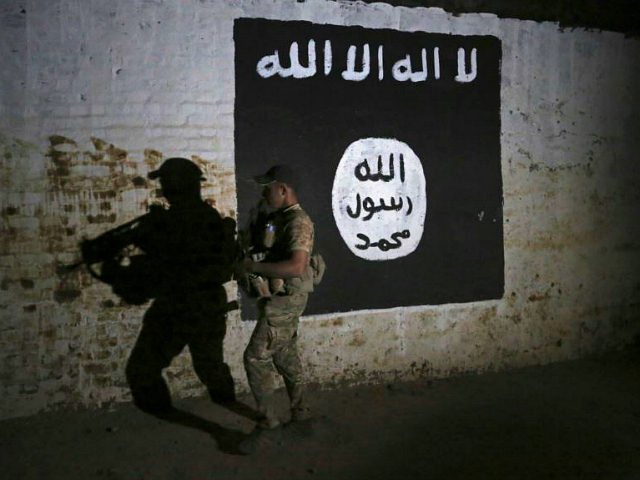The Islamic State (ISIS/ISIL) branch in Afghanistan has declined “in size, capability, and ability to hold territory” since the inauguration of President Donald Trump, who allowed the U.S. military to drop the largest non-nuclear bomb in its arsenal on the jihadist group, reports the Pentagon.
Nevertheless, the 20 terrorist groups in the Afghanistan-Pakistan region, including ISIS, “continue to present a formidable challenge to Afghan, U.S., and coalition forces,” warns the Trump administration in its first semi-annual report to Congress on Afghan war progress.
“The presence of as many as 20 terrorist organizations,” namely ISIS, the Taliban, al-Qaeda, and the Haqqani Network, among others, “creates the largest concentration of terrorist and extremist organizations in the world and a complex threat environment,” it adds.
Known as the Khorasan Province (ISIS-K), the ISIS wing in Afghanistan “regressed” during the period covered by the Pentagon assessment — December 1, 2016, through May 31, 2017.
“The current U.S. objectives in Afghanistan are to defeat threats posed by al Qaeda, support the ANDSF [Afghan National Defense and Security Forces], and give the Afghan people the opportunity to succeed and stand on their own,” notes the Pentagon:
In early 2016, the United States expanded counterterrorism objectives in Afghanistan to include targeting ISIS-K as part of the broader fight against ISIS. The focus on defeating ISIS-K increased significantly during this reporting period. The ultimate goal of U.S. and international efforts is a sovereign, secure, stable, and unified Afghanistan.
In April, American Gen. John Nicholson, the top commander of U.S. and NATO troops in Afghanistan, ordered the U.S. military to launch the 21,600 pound GBU-43/B Massive Ordnance Air Blast bomb (MOAB), known as the “mother of all bombs,” on a fortified network of underground tunnels used by ISIS-K.
MOAB killed more than 90 ISIS-K jihadists in eastern Afghanistan’s Nangarhar province, reducing the number of ISIS-K fighters to about 700. The group’s manpower peaked at about 3,000 fighters.
The U.S. military has identified Nangarhar as ISIS-K’s primary stronghold in the Afghanistan region.
“ISIS-K has regressed since its operational emergence and initial growth in 2015. Several factors have disrupted ISIS-K’s growth and diminished its operational capacity, including U.S. counterterrorism operations against the group, ANDSF operations, pressure from the Taliban, and difficulties in gaining local populace support,” reports the Pentagon. “During the last reporting period, ISIS-K had a limited presence in six provinces; however, it is now largely confined to four districts in southern Nangarhar Province.”
The Taliban and ISIS-K are regional rivals competing for fighters, territory, and influence. Taliban jihadists remain the most prominent and strongest terrorists in Afghanistan.
The group controls or contests about 35 percent of Afghanistan, according to the U.S. Department of Defense (DOD) report. U.S. Defense Secretary James Mattis recently admitted America is “not winning” the 16-year-old war.
The Pentagon assessment acknowledges that “ISIS-K remains a threat to security in Afghanistan and the Afghanistan-Pakistan border region and a threat to U.S. and coalition forces, and ISIS-K retains the ability to conduct high-profile attacks in urban centers.”
The Pentagon adds:
ISIS-K is still conducting low-level recruiting and distribution of propaganda in various provinces across Afghanistan, but it does not have the ability or authority to conduct multiple operations across the country. Moreover, command and control and funding from core ISIS elements in Iraq and Syria are limited. Still heavily reliant on external funding, ISIS-K is struggling to develop funding streams within Afghanistan, which has increasingly put it into conflict with the Taliban and other groups vying to raise revenue from illegal checkpoints and the trade of illicit goods.
ISIS-K continues to draw its members from disaffected TTP fighters, former Afghan Taliban, and other militants who believe that associating with or pledging allegiance to ISIS-K will further their interests.
TTP refers to the Pakistani Taliban or Tehrik-e-Taliban. The Trump administration is expected to escalate the U.S. military footprint in Afghanistan by up to 4,000 service members in response to the mess he inherited from his predecessor.
Currently, the U.S. military reportedly has a force of about 8,400 troops in the country.
“The ANDSF are at a critical point in the fight against the insurgency. The plan to modify the force structure and develop into a more agile and lethal force is underway, but 2017 is a year of setting conditions to build momentum,” notes the Pentagon.
ANDSF members, which include police and army units, “must weather the storm from the insurgency and deny the Taliban strategic victories on the battlefield, fight ISIS-K, grow and train… to become a more offensive force in 2018,” declares the Pentagon.

COMMENTS
Please let us know if you're having issues with commenting.